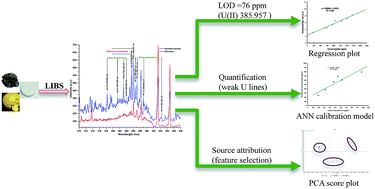当前位置:
X-MOL 学术
›
Anal. Methods
›
论文详情
Our official English website, www.x-mol.net, welcomes your
feedback! (Note: you will need to create a separate account there.)
LIBS development methodology for forensic nuclear materials analysis
Analytical Methods ( IF 2.7 ) Pub Date : 2018-01-08 00:00:00 , DOI: 10.1039/c7ay02520c Bobby Bhatt 1, 2, 3, 4 , Kalambuka Hudson Angeyo 1, 2, 3, 4 , Alix Dehayem-Kamadjeu 1, 2, 3, 4
Analytical Methods ( IF 2.7 ) Pub Date : 2018-01-08 00:00:00 , DOI: 10.1039/c7ay02520c Bobby Bhatt 1, 2, 3, 4 , Kalambuka Hudson Angeyo 1, 2, 3, 4 , Alix Dehayem-Kamadjeu 1, 2, 3, 4
Affiliation

|
Nuclear forensics (NF) is an important tool for the analysis of intercepted nuclear and radiological materials (NRM) to establish the relationship between NRM and their attribution in support of nuclear security. The critical challenge in NF at present is the lack of direct, rapid and non-invasive analytical techniques, especially for concealed and limited size NRM. Laser induced breakdown spectroscopy (LIBS) coupled with chemometrics has the potential to rapidly detect, quantify and attribute concealed NRM of limited sample size in air at atmospheric pressure. The goal of this study was to explore LIBS in air at atmospheric pressure in conjunction with chemometrics towards direct and rapid NF analysis. In this work, the limit of detection of uranium in cellulose was obtained at 76 ppm. The uranium lines at 385.464 nm, 385.957 nm and 386.592 nm were identified in the LIBS spectra of uranium trioxide (bound in cellulose) and uranium bearing mineral ores. The uranium lines were classified into weak and resonant lines based on the signal-to-background ratio. Multivariate calibration models utilizing weak and resonant uranium lines were developed using an artificial neural network (back-propagation algorithm). The model using weak lines predicted the uranium concentration in the certified reference material with relative error prediction (REP) = 4.32% while that using resonant lines predicted with REP = 9.75%, thus demonstrating the robustness of chemometrics enabled LIBS. The calibration model using weak uranium lines predicted uranium concentrations in Kenya's uranium-bearing mineral ores between 103 and 837 ppm. Principal component analysis based on spectral feature selection successfully grouped the samples into their mineral mines (origin). Thus, LIBS in air under atmospheric pressure combined with chemometrics not only realizes direct, rapid, minimally invasive detection and quantification of trace levels of uranium in typical uranium bearing mineral ores but also aids in source attribution of these ores.
中文翻译:

LIBS法医核材料分析开发方法
核法证学(NF)是分析被截取的核材料和放射材料(NRM)的重要工具,以建立NRM及其支持核安全的来源之间的关系。当前,NF的关键挑战是缺乏直接,快速和非侵入性的分析技术,尤其是对于隐蔽和有限尺寸的NRM。结合化学计量学的激光诱导击穿光谱法(LIBS)具有在大气压力下快速检测,量化和归因于空气中有限样本量的隐蔽NRM的潜力。这项研究的目的是探索大气中大气中的LIBS,并结合化学计量学进行直接和快速的NF分析。在这项工作中,纤维素中铀的检出限达到了76 ppm。铀线位于385.464 nm,385.957 nm和386。在三氧化铀(结合在纤维素中)和含铀矿物矿石的LIBS光谱中鉴定出592 nm。根据信噪比将铀线分为弱线和共振线。利用人工神经网络(反向传播算法)开发了利用弱铀线和共振铀线的多变量校准模型。使用弱线的模型通过相对误差预测(REP)= 4.32%来预测认证参考材料中的铀浓度,而使用REP = 9.75%的共振线来预测铀浓度,从而证明了化学计量学对LIBS的鲁棒性。使用弱铀谱线的校准模型可预测肯尼亚含铀矿物矿石中的铀浓度在103至837 ppm之间。基于光谱特征选择的主成分分析成功地将样品分组到了其矿山(产地)中。因此,在大气压力下的空气中的LIBS与化学计量学相结合,不仅可以实现对典型含铀矿物矿石中痕量铀的直接,快速,微创检测和定量,而且还有助于这些矿石的来源归因。
更新日期:2018-01-08
中文翻译:

LIBS法医核材料分析开发方法
核法证学(NF)是分析被截取的核材料和放射材料(NRM)的重要工具,以建立NRM及其支持核安全的来源之间的关系。当前,NF的关键挑战是缺乏直接,快速和非侵入性的分析技术,尤其是对于隐蔽和有限尺寸的NRM。结合化学计量学的激光诱导击穿光谱法(LIBS)具有在大气压力下快速检测,量化和归因于空气中有限样本量的隐蔽NRM的潜力。这项研究的目的是探索大气中大气中的LIBS,并结合化学计量学进行直接和快速的NF分析。在这项工作中,纤维素中铀的检出限达到了76 ppm。铀线位于385.464 nm,385.957 nm和386。在三氧化铀(结合在纤维素中)和含铀矿物矿石的LIBS光谱中鉴定出592 nm。根据信噪比将铀线分为弱线和共振线。利用人工神经网络(反向传播算法)开发了利用弱铀线和共振铀线的多变量校准模型。使用弱线的模型通过相对误差预测(REP)= 4.32%来预测认证参考材料中的铀浓度,而使用REP = 9.75%的共振线来预测铀浓度,从而证明了化学计量学对LIBS的鲁棒性。使用弱铀谱线的校准模型可预测肯尼亚含铀矿物矿石中的铀浓度在103至837 ppm之间。基于光谱特征选择的主成分分析成功地将样品分组到了其矿山(产地)中。因此,在大气压力下的空气中的LIBS与化学计量学相结合,不仅可以实现对典型含铀矿物矿石中痕量铀的直接,快速,微创检测和定量,而且还有助于这些矿石的来源归因。











































 京公网安备 11010802027423号
京公网安备 11010802027423号